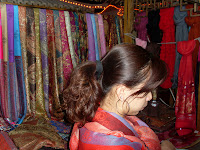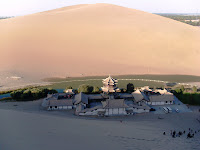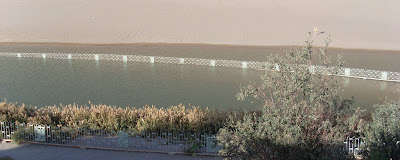Our first destination on our last day of this tour was Liangzhou Winery located in Leitei Park. This location was chosen for the winery because of the accessibility of water and for a region with great historic and cultural significance.
We saw a storeroom for baijiu 
Next we saw a processing room for hongjiu, 
Next we were taken to a historic Buddhist 
We also saw a museum on the history of the region and of Liangzhou Winery, including an ancient poem extolling the virtues of the wine of the region. There were many interesting relics: stone carving, earthen pottery, paintings and sculptures. A brief but interesting visit!
Day 52: Liangzhou Winery
Day 51: Shandan City
Our next stop was Shandan. It felt very much like home there 
We visited the Shandan Museum 
Before departing Shandan, we visited 
Read more on Rewi Alley here
I was very excited to hear that my home-district, Selwyn, is entering a Sister City Relationship with Shandan in Gansu, China. I wish them well!
Day 51: Rural Village Visit
Then we went to a rural village, set up as a model of socialist living. The village has four aims: to increase productivity, to increase the standard of living, to increase the cleanliness of the village, and to increase democracy.
Productivity has been increased by hitting niche markets, 
We were shown through a couple of villager's homes, which were quite comfortable but without the extravagence of the rural village of Qingyang. This was a success story of how the people can band together to improve all of their lives.
Day 51: Zhangye City Water Conservation
After breakfast we were whisked away to visit the Zhangye City Association for Science and Technology where we saw an exhibition on water utilisation and conservation in the region. As the city lies within the Hexi Corridor, between the Qilian Mountains and a series of hills, there is little opportunity for water collection. The largest source is the Black River which begins at the snow-capped Qilian Mountains and winds its way down. There is insufficient rainfall to make its collection practical (Ironically, this day it was raining but, as in Lanzhou, it was Canterbury-style drizzle so would not yield much actual water).
With the growing population there has been greater need to rationalise its use. There are numerous dams along it for enery production, and water collection and use within the city is limited. We were informed that each of our hotel rooms from the previous night was limited in water use per day.
The conservation of water is not only for Zhangye, but for the benefit of the Autonomous Mongolian Region bordering on it for whom the Black River also serves. It has been said that this water source is the greatest asset Gansu can provide Mongolia, and so protecting it is vital.
Zhangye is a key city along the Silk Road, with historic, cultural and economic importance. Our time in Zhangye was wonderful, but my attention was quickly pulled to the second home of Rewi Alley, Shandan.
Day 50: Zhangye City
Our next city visit was to Zhangye, a strongly agricultural region which also became the second home to a very famous New Zealander, Rewi Alley.
While in Zhangye we visited the Great Buddha Temple. 

The Great Buddha Temple holds the largest indoor, 
It was indeed an impressive collection, and that was not all Zhangye has to offer!
Day 49: Dunhuang Night Markets
On both nights that we stayed in Dunhuang 
There are all manner of items on sale: 

So, what did I buy? I bought a book on the Mogao and other local grottoes, 


Day 49: Minsha Mountain and Crescent Moon Lake
In amongst the dunes of the Gobi is a wonder called 'Crescent Moon Lake'. It is a natural lake surrounded by a sparse area of lush greenery before the sand wins over again. We visited this place, and took time for a few activities here also.
First we climbed the dune. Walking through sand is difficult, but walking up sand dunes is even more so, constantly slipping away from the destination. 
We were then taken to visit a caravan of camels, which were curious creatures. They walk with a swaying swagger and commune with a low moan. We were split into groups of four who then got to ride a group of camels as we were lead through the desert. This was not as unusual an experience as I'd expected, though perhaps unusual that they chose to serve us camel that evening...
Crescent Moon Lake is a wonderful place and well worth the visit. Thank you for sharing your beauties with us, Dunhuang!
Day 49: Yang Guan Pass
This Pass marked the entry point onto the Silk Road, and as such was used as a Visa point to enter China.
The museum there contained another comprehensive story of the Silk Road and many more relics found there. There was a display of plants introduced from China to the rest of the world which surprised me: it showed the grape, broadbean, carrot, and flax though far different from the New Zealand variety) amongst others. Another display showed a number of famous (ancient) Dunhuang people. Entertainment has clearly been a strength of Dunhuang for many years, the list including: Sui Cheng, Musician; Suo Jing, Calligrapher; and Zhou Fei, Artist. The list also included Song Qian, Educator; Gau Yu, Confucionist; and Gan Yin, Geographer.
In the spirit of the Pass being the gateway, we were each issued a mock passport with our own name handwritten by a calligrapher; and we were duly processed as we departed.
Counter to yesterday's display of defence against attack, outside the museum was a collection of fighting machines: a catapult, a battering ram, a similar device for tearing through walls, and a portable ladder. Whether those on display functioned could not be trialled, but it was exciting to see the other side of the barrage!
Day 49: Mogao Grottos
Now in Dunghuang City, we drove to Mogao Grottos. 'Mo' means desert, Dunhuang is located on the border of the Gobi Desert; and ' gao' means 'high', we are at great altitude. The Grottos were a place for prayer and meditation for the Buddhist people and are richly decorated with images and statues of Buddha, Bodhisattva and Apsaras. They were originally mostly open-air, but in the 1950s the Dunhuang Academy built protective hoardings to preserve the works from the elements. These works were, in a word, magnificent. Such rich colours, even though changed now by oxidation over the ages, and detail, and the change of design as the grottos were added to in different periods.
The first cave we entered contained at 25 foot statue of Buddha standing, the wall surrounding him containing One Thousand (not literal) Buddhas. This had been built over 29 years, first carved in the rockface, coated with straw and clay, then painted with mineral dyes. Time had revealed some of its inner construction, but it was still amazing.
In the next we saw a Reclining Buddha who had found Nirvana. This too was of great scale, and he was overlooked by 72 bas-relief statues of common folk which included many different ethnicities. The ceiling of this cave was tomb-like, fitting the scene.
In 1900 a self-appointed curator for the area, Taoist monk Wang Yuanlu, saw a crack in the hill and upon futher investigation 'The Hidden Library' was discovered -- a tomb containing many thousands of scrolls spanning hundreds of years. These scrolls now reside in museums around the world, but the tomb itself remains.
The Mogao Grottos were spectacular and must be seen. Photography of any kind is not allowed. Copies of the murals exist about Dunhuang, but they cannot compare to seeing the real thing.
Day 48: Jisco
Jisco is the Jiuquan Iron and Steel Group Company, and this morning we presented their exhibition hall and taken to see what of their sheet steel processing plants.
Asides from tourism, Jisco is again the lifeblood of Jiayuguan and has indeed done very well for the community. Their staff all receive very impressive salaries, the company has built apartment blocks, a swimming pool, gymnasium and parks for the community also. As a company, they had very difficult beginnings due to circumstances of the late-50's and 60's but since the 80's have done very well. They produce a variety of steel products: plate, wire, stainless steel; and have a thriving research and development division.
In recent years Jisco has diversified into other areas, one of their newest venture being the Zixuan Winery. Their first bottles of wine were produced in 2006, and immediately began winning awards. It is a fast growing operation, with a vineyard of 50,000 mu, and cellar of 5,700 oak barrels. They produce a selection of dry red wines and ice wines.
Jiayuguan is a highly developed region with thriving and supportive industries, and surely a bright future.
Day 47: Jia Yuguan City
The destination today was Jia Yuguan city, perched in the narrowest region of the Hexi Corridor. Travelling there it was clear was it was termed such: mountain ridges can be seen either side of the road. It is for this reason that the development of the Great Wall in Jia Yuguan was very strategic.
First was the location, in a dip that enables it to be hidden from the view of approaching enemies. When it did come into view, the tops of the walls were constructed with areas to place their torches so that they too could not be seen, so approaching enemies would believe the village be asleep. When the enemy was close enough, the villagers could quickly appear and take the offence. Finally, were the enemy to make progress, the fortress' front gate lead to a courtyard that, rather than being in the village as it appeared, was another trap. The 'front gate' would be opened, the enemy storm in, and then the gates would be closed, trapping the enemy in the courtyard.
We then travelled to the First Beacon Tower, 
Following dinner we were lead for a walk around the nearby park. In this park is a gigantic dolphin-like structure, on whose nose is resting a ball. 
Day 46: Jinchang City
Our week of visits began with a four hour drive to Jinchang, a city based on its mineral extraction. The city has 400,000 people and is noticeably quieter than Lanzhou with far fewer people and vehicles on the streets. We had lunch with the Vice-Mayor of the city, the regional director for the Foreign Affairs Office and others. The flavour of Jinchang seems to be quite spicy, most of the dishes had some degree of heat, and the local (non-alcoholic) beverage is Jujube juice (sour date juice).
The afternoon was spent looking about the city, for which JNMC, Jinchuan Nonferrous Company is clearly dominant, many of the buildings emblazoned with its logo. The heart of Jinchang is indeed its Nickel Mine. The practice of Open Mining was stopped in the 1980s, but those pits remain and we saw one of them. The tunnels underground which are in use now were visible, but the vehicles were dwarfed by their surroundings. We were shown an exhibition hall about the operations and also shown through one of their extractions plants, a truly mammoth operation.
Later we were taken to Jin Shui Lake (Grey Water Lake), a man-made lake developed to beautify the area. It is fed from the treated waste water of the extraction plant. There are actually six lakes in the 26 hectare park, which is beautifully landscaped. There is a notable lack of recreational areas except for one courtyard bordering on the lake where children ride the hover-boards, capture minnows in the lake, and enjoy the spectacular view.
We headed back to the hotel and were indulged in a banquet with the CEO of JNMC. By the end of it I was quite tired and ready for a long sleep. Tomorrow, to Jia Yuguan.
Day 44: Visit to Foreign Affairs Office
This afternoon we had a scheduled visit to the Gansu Foreign Affairs Office. We received three presentations: the first a presentation on Canada's geography, economics, politics and culture. The second was on "The Pride of Gansu", a list of which I will share below. Most items also link to more information, so please have a look and find out about the Prides of Gansu!
The third was on Modern Chinese Wedding Celebrations, a topic that I got some insight into the week before.
Without further ado, The Prides of Gansu:
- Dúzhě (读者) Magazine - circulation of 10 million each month
- Hand stretched noodles, found in popular Lanzhou dish, niú ròu miàn
- Mogao Grotto and Frescoes
- Shenzhou 7 Spaceship
- Jiuquan Satellite Launch Center
- Bronze Galloping Horse statue, discovered in Wuwei
- Shandan Military Horse Farm, biggest in Asia
- President Hú Jǐntāo and Premier Wēn Jiābǎo, who have both spent time in Gansu
- Corn Harvest, Gansu produces half of the China's corn
- Beer Barley, Gansu produces a quarter of the China's barley
- Traditional Medicine, Gansu produces many ingredients for traditional medicine
- Jinchuan Group Ltd (JNMC), Jinchuan Non-Ferrous Metal Company
- Jiuquan Iron and Steel Co. (JISCO), Jiuquan city
- "Copper City" of Baiyin
- Four vaults of Classical Books
- Emperor Fúxī (伏羲), survivor of Great Flood and repopulated with Nǚwā
- Goddess Nǚwā (女娲), survivor of Great Flood and repopulated with Fúxī
- Emporor Huángdì (黄帝), considered to be the ancestor of all Hàn Chinese
- Emporer Qín Shǐhuáng (秦始皇), first to unite China
- Poet Lĭ Bái (李白), regarded as one of the greatest poets in China's literary history
- Mogao Grape Wine
- Beauty Diāo Chán (貂蝉), one of the Four Beauties of Ancient China
- Mǎ Sānlì (马三立), cross-talk actor
- Compere Zhu Jun (朱军), CCTV presenter
- Compere Shuĭ Jūnyì (水均益), graduate of Lanzhou University
- Compere Lĭ Xiūpíng (李修平), CCTV presenter
- Lǐ Yáng (李阳), developer of "Crazy English", a new way for Chinese to learn English
- Scientist Qín Dàhé (秦大河), Former Director of the China Meteorological Administration
- Yumen Oil Field, first natural oil field of China
- Tower of Red Army's Force joining in Huining, commemorating the turning point for the Chinese Revolution from depression to victory
- Liújiāxiá Reservoir, first to be designed and constructed solely by Chinese
- Yellow River Elephant Fossil, at Gansu Provincial Museum
- Màijī (麦积) Mountain Grotto in Tianshui
- Tiānzhù (天柱) White Yak, Tibetan Autonomous Region
- Wushaoling Tunnel, longest in China (20.5km)
- Steel Bridge on Yellow River, built 1907
- Lanzhou is the geometric centre on the map of China
- West-East Natural Gas Transmission Project, 1/4 of which lies in Gansu
- Great Wall in Jiayuguan Pass, Ruins of the Ming Dynasty Great Wall
- Water Diversion Project, from Yangtze River to Gansu for irrigation, 800km long
- 'Postman', the symbol of China Post, found in murals of Jiayuguan City
- Potato, Gansu is the largest producer in China and have produced the new variety 'Black Beauty'
- Crescent Moon Lake in Dunhuang.
Day 43: Silk Market
A group of us made a venture to the Silk Market: Eva, one of the Indonesian girls; Ashley, the American; Andrew and myself. 
Andrew and I had actually visited the market a couple of times before, Andrew ordering a qípáo (旗袍) to be made for his girlfriend, but neither of us had yet ordered a suit.
It was Eva's first visit to the Silk Market, so we had a look around a number of the stalls. She decided not to purchase anything here though as she was also visiting Beijing where everything is cheaper (because of the size and location). 
The second stall was much more satisfying. Predictably, their starting price was much higher than we felt reasonable, but this was quickly brought down. Soon the stall-owner was taking measurements and I flicked through the pattern book. I am not sure what the final product will be like, but can collect it in a weeks time!
Another purpose for our visit to the Silk Market was to meet with a stall-owner there, Ming. We had met Ming on our first visit. He owns a button and zip store (very necessary in such a place!) 

